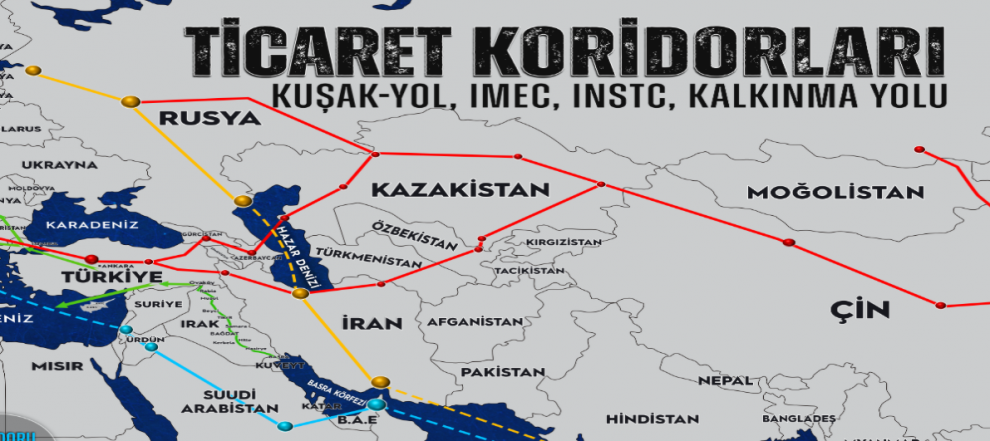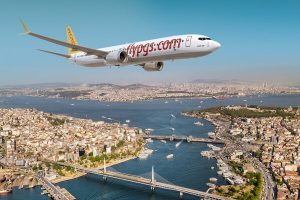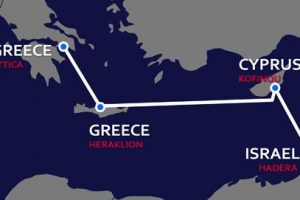As the world’s most strategic trade routes cross Turkey’s borders, the opportunities for competition and cooperation have never been greater. From the Belt and Road to the Development Road, from the European Union’s Global Gateway Project to the India-Middle East-Europe Economic Corridor, how do giant projects affect Turkey’s trade? Can Turkey become one of the playmaker actors in world trade?
In recent years, Turkey has made significant strides in establishing new trade routes. In this sense, the activation of the London-Beijing line passing through Istanbul and the Istanbul-Tehran-Islamabad railway line within the scope of the revitalization of the historical Silk Road, the importance given to the Central Corridor (London-Beijing), the Blue Homeland policy and the steps taken on the Development Road and the Zangezur Corridor can be considered as indicators of the importance attached to trade routes. On the other hand, the agendas regarding the existing, under construction and projected trade routes in the world have recently become one of the prominent agenda items of global competition. In this respect, which actors and which trade corridors Turkey is dealing with in trade routes has become an issue that needs to be analyzed in more detail. This is because the policies to be pursued on trade routes require various cooperation approaches with the actors neighboring the trade routes, as well as competition. In this sense, Turkey needs to build the most strategic policy that prioritizes national interests and regional and global peace.
Turkey’s neighbors in terms of trade routes can be evaluated through four main trade routes. These are China’s Belt and Road Initiative, the US’s India – Middle East – Europe Economic Corridor (IMEC), the EU’s Global Gateway and Russia’s International North-South Transport Corridor (INTSC). These four projects are trade routes that have the potential to affect Turkey’s presence and influence on trade routes. In this respect, it can be said that China, the US, the EU and Russia are Turkey’s neighbors on trade routes.
China’s Belt and Road Initiative
It is seen that China wants to create a strategic trade route network with the Belt and Road Initiative by making long-term plans with large investments in 2013. In this context, it can be said that China has emerged as the actor that Turkey is the closest and most intertwined neighbor in terms of trade routes. Because it is known that Turkey attaches importance to the Central Corridor, which refers to the line that reaches Turkistan geography through the London-Beijing line as the current corridor and from there to China. China’s influence on this trade route creates a mutual dependency in Turkey’s relations with China. However, the direction in which this interdependence operates is important for the relations between the two countries. In other words, there is a need for in-depth assessments on whether Turkey reaches new markets through this route or whether it is China’s market or a transit route serving China’s commercial ambitions.
In addition, it is also assessed that China is interested in the Development Road Project that Turkey has recently put on the agenda. Considering that China’s policy in the world focuses on building economic corridors and thus turning the world into a “market” and turning its production potential into profit, it is only natural that China would welcome projects that will strengthen existing trade corridors, accelerate and facilitate trade flows and create alternative routes. Moreover, the China-Pakistan Economic Corridor, an important line of China’s Belt and Road Initiative, extends to Pakistan’s Gwadar Port. At this point, the integration of this line with the Development Road means that China can quickly transport the products arriving at the Gwadar port to Europe via Iraq and Turkey. This situation is likely to produce results that contribute to China’s economic policy in the world. In other words, although trade routes will provide certain returns to the countries that are transit routes due to their use, it is a priority for Turkey to focus on routes where it can deliver its goods to existing markets faster and cheaper and provide access to new markets.
International North – South Transportation Corridor (INSTC)
This corridor, which was initiated by Russia, Iran and India and has since been joined by Azerbaijan, Armenia, Belarus, Kazakhstan, Tajikistan, Turkmenistan, Ukraine, Bulgaria, Turkey, Oman and Syria, has an important function on the north-south axis. However, the geographical distance between the countries that form the basis of the project, the presence of regions along the corridor route that are difficult to stabilize, and the cautious approach of actors to this line due to the US sanctions on Iran are the challenges facing the INSTC. In its current form, the functioning of the corridor limits the opportunities offered by the corridor for Turkey. In other words, the transportation route through the corridor is not focused on Turkey. Nevertheless, since Turkey is one of the countries involved in the project, it will be able to use this line to the extent it needs to transport goods to Turkey and Europe. On the other hand, the fact that Chabahar Port is the subject of India-Pakistan rivalry as it is considered as an alternative to Gwadar Port, and furthermore, the fact that China’s Belt Road prioritizes Gwadar and the INSTC, where the India-Iran-Russia triumvirate stands out, prioritizes Chabahar points to the political orientations of this line.
Russian President Vladimir Putin paid a visit to Baku in August 2024 after a long absence. One of the issues Putin raised during the visit was the development and strengthening of INSTC’s transportation lines in Azerbaijan and Iran in order to improve trade relations between the two countries. It is understood that Russia wants to develop this line due to the instability that has not yet ended in the region after its invasion of Ukraine and its search for new markets.
Turkey is not one of the decisive countries of this economic corridor. In this respect, although the INSTC offers some opportunities for Turkey in the current conditions, Turkey’s influence in providing these opportunities seems to be limited.
On the other hand, the Zangezur Corridor was excluded from the agreement in order to expedite the Azerbaijan-Armenia peace agreement due to its contentious issues. It is not yet clear how this development will affect the operationalization of the Zangezur Corridor. If the peace agreement is accelerated and the developing peace process creates a more reasonable ground for Zangezur, this may have positive consequences for the operationalization of the corridor. On the other hand, if the peace agreement process is not positively affected by this development, or if the Zangezur Corridor is not prioritized by both sides after the peace agreement is signed, new uncertainties and delays could arise.
India – Middle East – Europe Economic Corridor (IMEC)
The agendas regarding the IMEC corridor have mostly emphasized assessments of the US-China global competition. Announced at the G-20 Summit in India, which Russia and China did not attend, the IMEC was positioned as an alternative route to China’s Belt and Road Initiative, but the difficulties of the route and the bypassing of a country like Turkey, which could shorten the duration of the route and facilitate the project, brought about controversy. In other words, the project has mobilized issues of political competition rather than improving economic mobility.
Turkey is likely to be negatively affected if the IMEC project is realized. On the other hand, the difficulties in realizing the project despite the fact that it has been put on the agenda provide Turkey with an opportunity to accelerate preparations for the Development Road Project. The Development Road has the potential to be a more preferable route than IMEC in terms of cost and time advantages. Moreover, Israel’s genocide in Gaza and the instability it has spread to the region increase the risks of the IMEC project, while the uncertain situation of the Suez Canal strengthens the search for alternative routes. In this respect, the need for alternative routes such as the Development Road Project is multiplying.
European Union Global Gateway Project (EU Global Gateway)
The Global Gateway Project was launched and introduced by the EU in December 2021. The timing and detailed information on the project is seen as the European Union’s response to China’s Belt and Road Initiative. In particular, China’s dominant role in the functioning of global supply chains during the pandemic, as well as its increasing influence in trade from Africa to Europe with the Belt and Road Initiative has mobilized the EU. In this sense, the EU’s allocation of 300 billion euros of budget resources for the Global Gateway Project between 2021 and 2027 shows the importance attached to the project. In addition, EU representatives emphasized that the Global Gateway Project focuses on building a new future for young people by creating sustainable and strong connections between countries rather than creating dependency in the world. In addition, it was stated that the project will support smart investments in quality infrastructure that respects environmental standards on the basis of EU principles and norms.
Moreover, in the context of arguments that Turkey’s trade with China is unfavorable to Turkey and that Turkey is unilaterally becoming an important market for China, it is important for Turkey to turn the Global Gateway Project into a framework for building its own network of trade routes around the world. This could accelerate Turkey’s economic integration with the world and promote cooperation with partners that emphasize mutual rather than unilateral trade. The funding to be provided by the EU and the EU’s increasing need to reach the Turkestan geography due to the war in Ukraine increase the importance of Turkey in the Global Gateway Project. In this sense, it is possible for Turkey to turn the opportunities provided by its location into action by combining them with the opportunities arising from the competition between China and the EU, two important commercial actors in the world.
Turkey’s Corridor Strategy
Turkey should analyze its real neighbors well in the economic competition developing through trade routes in the world. At this point, China, the US, Russia and the EU are the main actors with which Turkey will cooperate and compete. Turkey has to strike a balance between these competitors that will maximize its economic interaction with the world. It should turn to policies that will reverse the current trend in its trade routes policy with China, which has gained a certain influence in this field and seems to have a negative picture in its mutual trade. In this context, in the Global Gateway Project of the EU, which is trying to take important steps against China by lagging behind China, it should focus on developing trade relations with the EU focused on mutual interests and maximizing its existing importance due to its position in the project. It should also project the US-led IMEC project to its partners as a driving force to finalize the Development Road project faster. In the case of the INSTC, Turkey should try to steer the development of the corridor as transportation through Turkey is increasing and Turkey’s products can reach the markets it wants to reach. If Turkey will not find the response it expects in this corridor due to actors such as Iran, Russia and India, it should focus on the construction and operation of corridors where it is more central in its trade route policies. On the other hand, Turkey should not ignore China-Pakistan’s preference for Gwadar and India-Russia and Iran’s preference for Chabahar Port.
In sum, building alternative trade routes is important for Turkey to increase its economic interaction with the world. However, it is even more important for Turkey to build trade routes that will strengthen its ability to develop independent economic policies without being dependent on actors such as China. In addition, Turkey should focus on trade routes for exporting high value-added products and be prepared for actors who want to create unilateral dependence on imports. Corridors usually end up in India or China. At this point, Turkey should not neglect to build trade routes with countries such as Pakistan and strategically located Afghanistan, with which it has close cooperation, and to strengthen its trade with these countries.
References
1 https://www.aa.com.tr/tr/analiz/kalkinma-yolu-projesi-umut-veriyor/3317669
2 Uluslararası Kuzey-Güney Taşımacılık Koridor, Türkiye Cumhuriyeti Ticaret Bakanlığı, 2019. https://ticaret.gov.tr/blog/ulkelerden-ticari-haberler/iran/uluslararasi-kuzey-guney-tasimacilik-koridoru
3 https://aric.adb.org/initiative/international-north-south-transport-corridor
4 https://www.trthaber.com/haber/dunya/rekabetle-cikarin-kesistigi-liman-cabahar-857707.html
5 https://www.hurriyet.com.tr/yazarlar/abdulkadir-selvi/putinin-aliyeve-teklifi-42509557
6 https://www.aa.com.tr/tr/dunya/azerbaycan-ve-ermenistan-ulasim-hatlarinin-baris-anlasmasi-sartlarindan-cikarilmasinda-anlasti/3298724
7 https://www.dw.com/tr/abden-%C3%A7inin-i%CC%87pek-yoluna-rakip-proje-global-gateway/a-59987903
Source: https://stratejiturkiye.com/gorus/ticaret-yollarinda-turkiyenin-komsulari






